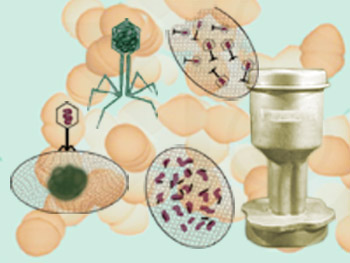Concept 18 Bacteria and viruses have DNA too.

Microscopes proved the existence of single-celledbacteria. However, there was debate about whether bacteria had genes and what attributes they may have in common with higher life forms. This debate was settled in the 1940's, when it was discovered that bacteria have sex. During the process of conjugation, genes are exchanged through a mating channel that links two bacteria.
Electron microscopy suggested that bacterial viruses carry on a similar process. A virus attaches to a host bacterium and injects its genes through its channel-like tail. In 1952, Alfred Hershey showed that DNA, alone, is responsible for the reproduction of new viruses within an infected cell. This provided undeniable support for Avery's earlier experiments that a gene is made of DNA. It also showed that viruses, as well as bacteria, can be used as models for studying universal principles of genetics.
 DNA and proteins are key molecules of the cell nucleus.
DNA and proteins are key molecules of the cell nucleus. One gene makes one protein.
One gene makes one protein. A gene is made of DNA.
A gene is made of DNA. Bacteria and viruses have DNA too.
Bacteria and viruses have DNA too. The DNA molecule is shaped like a twisted ladder.
The DNA molecule is shaped like a twisted ladder. A half DNA ladder is a template for copying the whole.
A half DNA ladder is a template for copying the whole. RNA is an intermediary between DNA and protein.
RNA is an intermediary between DNA and protein. DNA words are three letters long.
DNA words are three letters long. A gene is a discrete sequence of DNA nucleotides.
A gene is a discrete sequence of DNA nucleotides. The RNA message is sometimes edited.
The RNA message is sometimes edited. Some viruses store genetic information in RNA.
Some viruses store genetic information in RNA. RNA was the first genetic molecule.
RNA was the first genetic molecule. Mutations are changes in genetic information.
Mutations are changes in genetic information. Some types of mutations are automatically repaired.
Some types of mutations are automatically repaired.